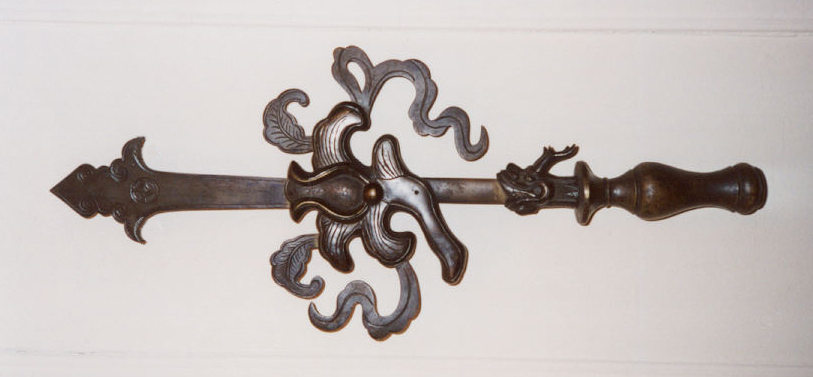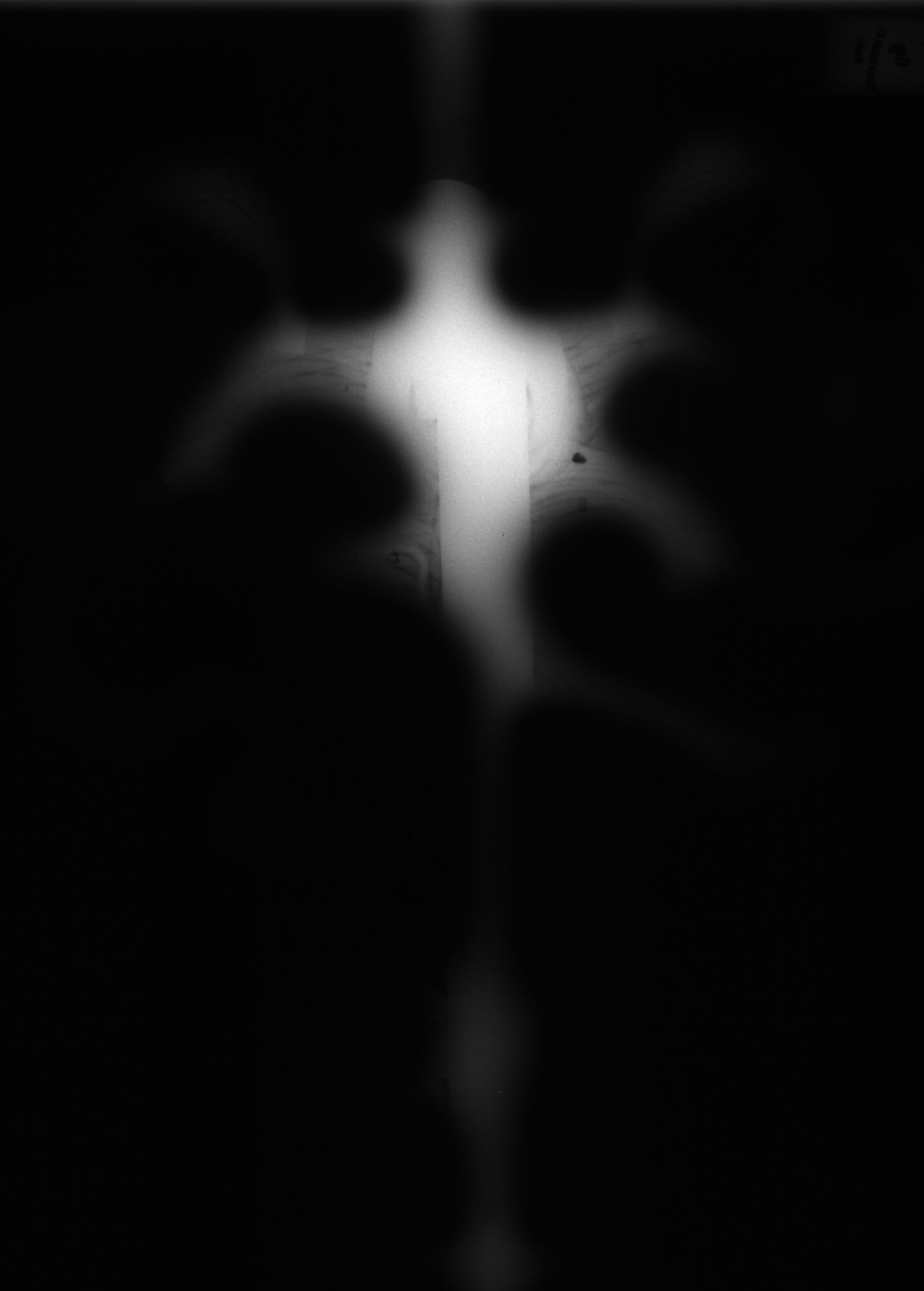 |
(Photo GW Hougham)
Asian Mystery Object
This object is a mystery: What is it? How old is it? Where did it come from? There are many clues but few solid answers... stay tuned as I research this intriguing object. If you have some ideas, please send them over.
The dimensions are 25 1/4" x 10 5/8" x 2 1/4" and it appears to be an ornamental fixture rather than a practical tool or implement. It appears to be of Asian origin, or at least made under Asian influence. It also appears to have been in the West since about 1903 because of evidence to be revealed below.
The pieces of metal are pinned together, and some pieces are somewhat movable, but others are pinned tightly and are immobile. The central medallion is suggestive of either clouds or a plant-like material, either fungus or lotus plant are my guesses. "Veining" in the leaves or tendrils suggests a plant like a lotus (or maybe fungus) rather than clouds. The veining carving is not of the finest workmanship, and this suggests it was made to be viewed from afar, rather than from close in. The small decorative dragon (or deer?) head slides up and down the bar-like central shaft over about two inches of travel.
Click on images for larger versions. (Three photos above courtesy Craig Harris.)
The Chinese and Japanese kanji character for the numeral "5" ("Go" in Japanese) is cut carefully into the underside of the large root-like protuberance at the "bottom" of the central floral emblem. It is about 0.8cm in both height and width. No other signatures, characters or marks are visible. The overall impression is of a well made Japanese or Chinese ornamental metalwork piece.
 |
 |
(Click on images for LARGER versions.) Left radiograph shows truncated outline of the piece - dragon antler shadow is visible in the lower part of the frame. Right radiograph, taken with a much longer and intense exposure, burns through the bronze to reveal construction details within the central medallion. Note the "leaf veining" visible as narrow dark and intersecting lines, and the pinned mortise and tenon construction technique used to attach the "leaf fronds". The small dark circular shadow at the "4 o'clock" position appears to be a hole in the surface where the vein chiseling has cut through a thin portion of the wall. Absent are any further "hidden" identification markings beyond the chiseled "five" on an external surface, oblique to this view. (Radiographs taken at two exposure factors: Left, 1/30 sec., 100mA, 60kV; Right, 1/2 sec., 200mA, 80kV. Both taken on Kodak TMG RA-6 x-ray film with Fisher medical x-ray equipment, at approx. 100cm film-focal plane distance.)
So, what is it? Some conjectures so far:
1) Battle standard. As there is an opening for a shaft or dowel insertion, along with a small pin hole to secure such a shaft, it appears that it should be mounted on a pole or shaft of some kind. Perhaps meant to be a battle standard carried into the field? Some of the metal fittings are tightly pinned, but several seem intentionally loose, to allow for some limited movement of the pieces. If the shaft upon which this ornament were mounted was carried while marching, the up and down rhythmic movement of the entire assembly would cause the metal fittings to clank with a mechanical or metallic sound. A large number of such clanging implements would likely make a frightening sound during a procession. Is there any evidence in the literature that this kind of practice was used?
2a) Temple ornament or ritual object. The central floral decorative piece is highly suggestive of a lotus plant, used ubiquitously throughout Buddhist iconography. If the object were mounted on a shaft, it could be used as an alter piece either point up or point down, suspended from the ceiling. If such was the case, we might expect to see an object like this in pairs. On the other hand, Bernard Faure, in his Visions of Power: Imagining Medieval Japanese Buddhism, discusses the shujou, or ritual shaft, used by the temple master as he ascends in the hall. In short, the shujou is the symbolic equivalent of the cosmic pillar, filling the space between earth and heaven. The shujou was originally a monster who was converted to a sacred being by the Buddha, and tasked to pacify and convert all beings. This monster could swallow earth and heaven, and so his body eventually took the pillaresque embodiment of a shaft connecting the two realms. The mystery object has a little "monster" dragon mounted on the central shaft: from his mouth emerges a "ken" shaped sword or blast of fire. The object could be the topmost portion of such a shujou.
2b) Another possibility is that it is a shakujou, discussed and pictured in Morse and Morse, 1995, Object as Insight: Japanese Buddhist Art and Ritual. A shakujou is a similar object, mounted as a standard at the end of a long pole. One use of this implement is as a kind of noise making rattle, to scare away snakes or other small animals in the path of an approaching mendicant, or simply to announce a wandering monk's arrival as he entered town. As this object is quite heavy, it seems unlikely that it would be carried about in such a manner; these objects have achieved a largely ceremonial function since medieval times, so if this object is a shakujou it is probably of more recent origin.
2c) Godai Myoo object A friend, Peter B. suggests I look into the Fudo Myoo figure in Japanese Buddhism. I've since come up with another idea related to Fudo... it's about another related diety called "Gouzanze Myou," who guards the east. As I mentioned above, the Japanese kana for the numeral "5" is carved into the object, and these two (Fudo and Gouzanze) are two of a group of, you guessed it, FIVE Myoo.... coincidence, or numerology? Further, in Nihongo, "5" is romanized as "go" (GOuzanze), but the romanization/kanaization itself means little for there are many kanji that are kanaized as "go." Hence, I need to look into the etymology and history of Gouzanze Myoo and the group of five myoo collectively known as Godai Myoo (again with "go"). The three others are Gundari, guarding south; Daiitoku, guarding west; Kongo Yasha, guarding north.
This line continues.... Gary G., another friend, adds, "I have a ceremonial sword from Tibet that is somewhat similar with regard to a flaming blade issuing from the mouth of a dragon. As well, I have seen others that have quite intricate metal-work flames attached to the blade--as this one appears to have a flower and leaves. Also, there is often a dorje (or thunderbolt) handle on such ceremonial swords. These ceremonial swords are used to cut through the worldly attachments, the great illusions and the 108 defilements in a Buddhist ceremony. Such swords can be found not only in Tibet/Nepal/Bhutan but throughout Asia including Japan (Shingon and Tendai Buddhist temples)."
There are many other such ritual tools that these diety guards use. Shukongojin, for example, uses not a sword with a dorje handle, but holds a thunderbolt proper (single pronged kongo or kongo vajra) in his fist as his weapon.
Update: 9/28/04
Now comes an extremely promising lead from a father/son team who happened into the site the other day. Jerome and Lar Short suggest that the object is a highly stylized ritual sword ("chi no ken" in Japanese, "vajra khadga" in sanskrit), wielded by the Bosatsu (Bodhisattva) Manjushri (in Sanskrit, or "Monju Bosatsu" in Japanese).
Jerome sent me some great links to check out, and sure enough, there are striking similarities in various depictions of Manjushri's sword to this object. Stay tuned for some links and a fuller explanation, but see: http://www.onmarkproductions.com/html/monju.shtml for a good discussion of how Monju Bosatsu fits into the Buddhist pantheon of deities, or http://www.cheppu.com/old/img/KDGA.jpg for one example Khagda, but from a slightly more Tantric Buddhist tradition: "The Khadga is a Buddhist symbol of enlightenment used to destroy [the knots of] ignorance, which is the enemy of liberation from the bonds of worldly attachments."
(Click on images for larger versions.)
Other evidence and speculation: Above, I mentioned a reference to 1903. Inside the end of the shaft hole opening was a newspaper wad, inserted in such a way as to suggest that it had been used to wrap around the end of the long gone shaft to tighten the fit between the shaft and the inner cylindrical shape of the end fitting. Careful removal of this brittle, dry, newspaper was possible (sadly, it was torn in two during this operation). This newspaper shard is from the Louisville [Kentucky] Courier-Journal, dated July 4, 1903. What does that tell us?
Possibly, that the object was at one time somewhere in the circulation area of the Courier-Journal. There may have been a Buddhist group there as a result of Japanese or Chinese immigration and settlement; some ritual objects to effect religious practice could have been brought with them. It might have traveled with one of the many Chinese railroad work groups and shanty towns from earlier in the previous century, and ended up in a "curio" shop in the middle of Kentucky. It might also have been imported from abroad as part of the 1893 World Columbian Exposition in Chicago, which had both Chinese and Japanese pavilions of rather extravagant design and architectural pretension. Or, it might have been brought back from the Far East by a wealthy midwestern businessman as a souvenir of his travels. Or, perhaps it was brought here as a gift by a visiting delegation.... Who knows?
(Click on images for larger versions.)
If you have any ideas, please send them along!
(This page last updated 1/29/2003)
|
 Mail to: ghougham@yahoo.com
Mail to: ghougham@yahoo.com![]() Back to Nihonto Viewing
Back to Nihonto Viewing
![]() Back to GH home
Back to GH home
 Mail to: ghougham@yahoo.com
Mail to: ghougham@yahoo.com![]() Back to Nihonto Viewing
Back to Nihonto Viewing
![]() Back to GH home
Back to GH home